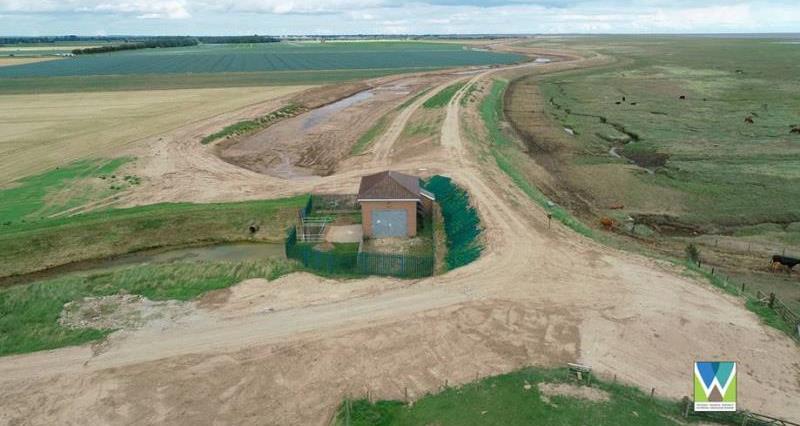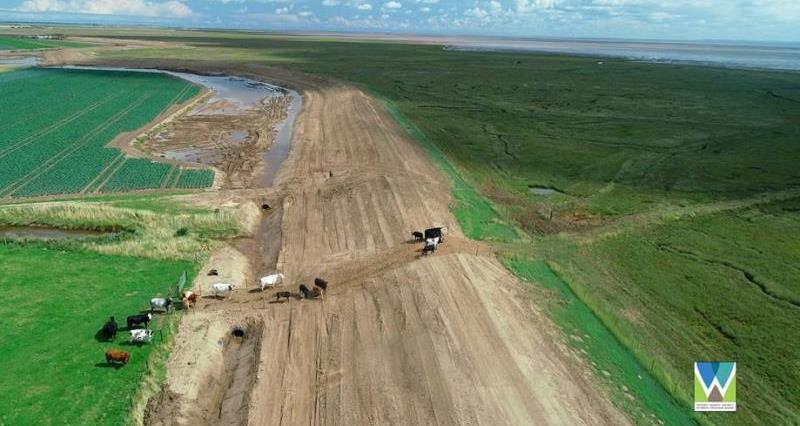In an area of the Wash shoreline previously viewed as in serious danger of being inundated by the North Sea, particularly in light of the devastating flood of 1953 when waters reached as far as two kilometres inland, a partnership project led by Witham Fourth District Internal Drainage Board (W4IDB), has raised and re-profiled sea defences.
The ambitious project has boosted protection for both properties and farmland, as well as creating additional wildlife habitats.
An Environment Agency review back in 2012 identified a 5km stretch of The Wash sea defences near the village of Wrangle in the Borough of Boston as particularly vulnerable, with the lowest sea banks along the Wash frontage and only a single line of defence.
Read more: Moving from abstraction licences to permits
The scheme involved re-profiling the sea banks and raising them to over seven metres high, with a one in three-rear slope leading to a soke dyke to cope with future over-topping.
The project has created a maintenance strip behind the bank and larger soke dykes. During high tides, these accommodate the water that permeates up through the ground and during heavy rainfall, they enable surplus water to flow to the W4IDB managed pumping stations.
It was the tidal surge of December 2013, again breaching the main line of defence just as it had 60 years earlier, that galvanised farmers and landowners to push for action.W4IDB were approached by the EA to lead on the project and a Project Board was set up with partner representatives from Lincolnshire County Council, the landowners, EA and Natural England to deliver the project.
W4IDB agreed to be the lead risk management authority on the project as they were able to deliver efficiencies using local landowner agreements and local contractors.
Read more: NFU calls for united approach to tackle climate change
This partnership approach, combined with the number of households and businesses protected, including significant industrial units such as pack-houses, enabled an application of support through DEFRA and EU funding, with a combined total of almost 1.8 million secured to complete the works.
Peter Bateson, chief executive of W4IDB, said: "This was a comprehensive project that followed a major survey in 2016 to identify the existing profile of the banks, collect environmental information and to assess the full scope of the works.
"Crucially, the programme required the buy-in of all involved, particularly landowners and businesses, as well as the local community. We also were very conscious of our environmental commitments, and liaised closely with Natural England, RSPB and the Lincolnshire Wildlife Trust."
As well as creating enhanced sea defences, the Wrangle Sea Banks project has enabled at least 10 hectares of habitat creation behind the banks including grassland and semi-wetland habitats.
"Landowners have contributed around 40 linear metres of farmland to provide the spoil to re-profile the sea banks. This equates to a considerable donation of land, from farmers, to be converted to non-farm use and habitat gain," added Mr Bateson.

It was a highly sensitive project, as the area sits alongside a Site of Special Scientific Interest (SSSI). It was crucial to tally the environmental considerations with the development and design of the bank, while retaining as much of the important agricultural land as possible for grazing and food production.
"The Project Board held monthly meetings during the planning stages, that included making plans for the management of the cattle that graze the salt marsh, and preserving the organic pasture behind the existing sea bank," said Mr Bateson.
It was this joined up approach, and the buy-in from landowners such as Hugh Drake, that enabled the project to proceed.
Mr Drake, who farms 800 acres on the northern edge of the Wrangle project, growing wheat, vining peas, brassicas and potatoes, was one of the landowners contributing farmland.
Read more: The Agriculture Bill - all the information in one place
He said: "The government's recognition of the vulnerability of the sea-defences on the western side of the Wash has been a great step forward and follows the damage done by the events of December 2013.
"In those parts of the sea-banks where there is only a single line of defence the risks of flood damage to valuable farmland, residents and property, as well as the substantial business enterprises in the area, have now been addressed and the Wrangle project is a step in the right direction to improve the resilience of the sea-defence.
"Farmers and landowners have made a very significant contribution in kind to the project by sacrificing their land, which has been estimated at 50 acres of some of the best food-producing land in the country.
"It will be an indication of the government's commitment to environmental issues, when the environmental enhancements of the whole scheme are properly recognised and form part of agriculture's contribution to current and future Stewardship Schemes."
Read more: Fenland Middle Level - Review of water management during 2018 drought
Cllr Colin Davie, of Lincolnshire County Council, said: "I am delighted to see the successful completion of this latest major scheme.Lincolnshire's flood risk and water partnership was put together six years ago, to promote exactly this kind of co-ordinated working, where each organisation contributes its own specialism to achieve more for our communities and businesses than would have happened were we all working alone.
"In this case, using £1.3m of DEFRA grant funding we have secured an additional half a million pounds of external investment that would otherwise have gone somewhere else.I look forward to our partnership continuing to attract more external funding to help secure a stronger economic future for our county."
The board said this major centre for food production and processing has never been better defended against the risk of coastal and river flooding, helping to protect the people, towns, business and farmers in this part of the Fens.
Mr Bateson added: "This was the first major improvement to coastal flood defences in the area for over 30 years, and by working in partnership, W4IDB has been able to help protect farmland and residents for future generations, while remaining sympathetic to the environmental responsibilities in this unique area."
